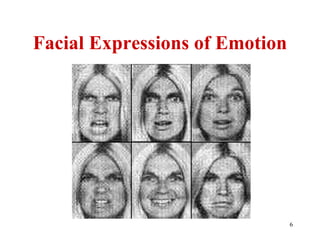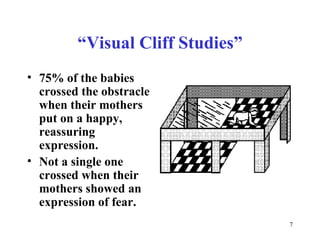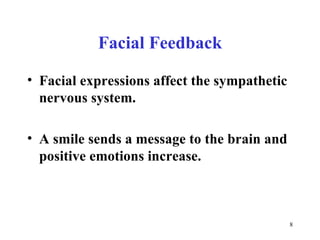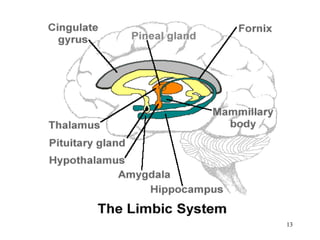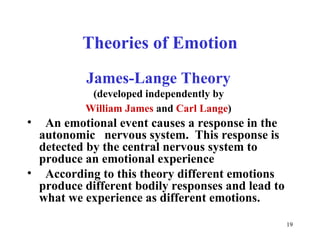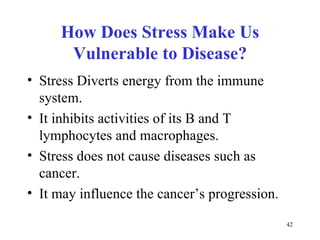11. emotions 07-08
- 1. The Physiology of Emotion ARISTOTLE: “People were THINKING ANIMALS. What makes people special is they can overcome their brutish emotions”. ROUSSEAU: “Emotions are what makes people special and gives us a reason for living”.
- 2. Emotion ( Branches) (Gardener) Thoughts and Culture and ex- explanations perience and ex- pression of emotion (Root and Trunk) Biological capacity for emotion
- 3. Characteristics of Emotions Emotions are accompanied by both physiological and cognitive changes Emotions are polar: they are either positive or negative Emotions influence behavior
- 4. Elements of Emotion Physiological changes in the face, brain, and body Cognitive processes such as interpre-tations of events Cultural influences that shape the experience and expression of emotion
- 5. Face and Emotion ( Paul Ekman) Neurocultural Theory 1. Universal neurophysiology in the facial muscles 2. Culture-specific variations in the expression of emotion Seven Universal Facial Expressions of Emotion: anger, happiness, fear, surprise, disgust, sadness, and contempt
- 6. Facial Expressions of Emotion
- 7. “ Visual Cliff Studies” 75% of the babies crossed the obstracle when their mothers put on a happy, reassuring expression. Not a single one crossed when their mothers showed an expression of fear.
- 8. Facial Feedback Facial expressions affect the sympathetic nervous system. A smile sends a message to the brain and positive emotions increase.
- 9. The Brain and Emotion Left Hemisphere Important for the expression of positive emotion Damage to the L.H. leads to loss of the capacity of joy. Activation in the L.H. leads to tendencies to approach other people. Right Hemisphere Important for the expression of negative emotion Damage to the R.H. may make people euphoric. Activation in the R.H. leads to tendencies to withdraw from people.
- 10. Brain region - Cerebral cortex Frontal Lobe Damage to the frontal lobe produces difficulty in inhibiting emotional responses. Temporal Lobe Damage to the temporal lobe can result in a Klover-Bucy Syndrome: people and other animals that have this damage experience tameness, a loss of fear and hypersexuality.
- 11. Brain region - Hypothalmus Hypothalmus (a part of the forebrain). Lesioning parts of the hypothalmus produces animals that are tameness and unmotivated and is thought to result in a flat affect.
- 12. Brain region - Amygdala ( is a structure in the limbic system ) Is responsible for evaluating sensory information and determines its importance Makes initial decision to approach or withdraw from situation Its initial response may be overridden by a more accurate estimation by the cerebral cortex
- 14. Hormones and Emotion You perceive the sensory stimulus. The adrenal gland sends two hormones: epinephrine and norepinephrine. They activate the sympathetic nervous system. That produces a state of arousal or alertness that provides the body with the energy to act (the pupils dilate, the heart beats faster, and breathing speeds up).
- 16. Autonomic Nervous System In threatening situations sympathetic nervous system releases nor-epinephrine (adrenaline) which produces marked physiological changes : Palms sweating Increased heart rate Focused attention Greater skin conductance (particular response may depend on what particular emotions one is experiencing)
- 17. The Brain’s Shortcut for Emotions We feel some emotions before we think. Some neural pathways involved in emotion bypass the cortical areas involved in thinking. One such pathway runs from the eye or ear via the thalamus to the amygdala, the emotional control center. This shortcut enables a quick, precognitive emotional response before the intellect intervenes. The cortex can override the decision of the amygdala to react.
- 18. Detecting Emotion - Lie Detectors (polygraphy) It measures several of the arousal responses that accompany emotion, such as breathing, blood pressure, and perspiration. The polygraph cannot distinguish between anxiety, irritation, or guilt; all appear as arousal. An innocent person might respond with heightened tension to the accusations.
- 19. Theories of Emotion James-Lange Theory (developed independently by William James and Carl Lange ) An emotional event causes a response in the autonomic nervous system. This response is detected by the central nervous system to produce an emotional experience According to this theory different emotions produce different bodily responses and lead to what we experience as different emotions.
- 20. James-Lange Theory Stimulus (Sight of Oncoming Car) Arousal (Pounding Heart) Emotion (Fear) EVIDENCE FOR THE THEORY 1. Different emotions do seem to be accompanied by somewhat different autonomic reactions. For instance, positive emotions tend to be accompanied by increased blood flow to the limbs and constriction of the pupils while negative emotions lead to the opposite. 2. Patients with spinal cord damage sometimes report experiencing emotions less intensely than people without spinal cord damage.
- 21. James-Lange Theory PROBLEMS WITH THE THEORY : 1. Patients with damage to their spinal cords often report feeling less intense emotional experiences but they still do experience emotions. In fact, sometimes quite intense emotions. 2. Injection with epinephrine produces arousal much like that of the sympathetic nervous system but by itself does not lead people to experience an emotional response. 3. The onset of emotional experiences appears to be rapid for it to be accounted for completely by feedback from the autonomic nervous system.
- 22. Cannon-Brad Theory Stimulus (Sight of oncoming car) Arousal + Emotion (Pounding heart, Fear) Emotional experience is produced both by the autonomic nervous system and by the brain. In particular emotional stimuli simultaneously produce a response in the autonomic nervous system and in the cerebral cortex. The emotional experience is the combination of those two experiences. The influence of the cerebral cortex in controlling emotion can be shown in the phenomenon of sham rage. When animals have their cortex removed they will go into extreme rages at the slightest provocation (sham rage - the response is often unrelated to the provocation and is short lived).
- 23. Schacter and Singer Cognitive Labelling Theory Stimulus (Sight of oncoming Car) Arousal Cognitive Label (Pounding Heart, “ I’m afraid”) Emotion (Fear) According to this theory emotions are produced when autonomic arousal is noticed by the person. He/she tries to come up with an explanation for the arousal and depending on the explanation they come up with may label it an emotion.
- 24. Two-factor Theory of Emotion Stanley Schachter & Jerome Singer 1962 Emotion depends on 2 factors: 1- Physiological arousal 2- The cognitive interpretation of that arousal Unless you can interpret, explain, and label the bodily changes, you will not feel a true emotion.
- 25. The Case of Shame & Guilt Shame Focus is on “bad self” Failure is regarded as a personality defect. He feels worthless and powerless. Cognitive appraisals that lead to blaming the person who was the reason for the shame. Guilt Focus is on the bad behavior The bad act doesn’t affect the the overall worthiness of the self. Guilty people have remorse and try to fix their faulty actions.
- 26. The Case of Shame & Guilt Shameful people say: “ How could I be such a horrible person ?” “ I did that horrible thing because I am a horrible person!” “ It cannot be fixed!” Guilty people say: “ How can I make such a horrible thing ?” “ I make mistakes because I am a human being” “ I can correct it”
- 27. Mental Development Infants Cognition is basic. Do not feel shame Cerebral cortex is not fully developed. Cognitive appraisals are basic. Emotions are not complex. Adults Cognition is complex. Cerebral cortex is developed. Cognitive appraisals & emotions are complex. Emergence of self-consciousness
- 28. A short madness Or Makes any coward brave??? Anger
- 29. Chronic hostility is linked to heart disease. Anger makes you react more assertively. Anger leads to talking things over with the offender. In societies that value their interdependence consider anger as a threat to group harmony. Anger
- 30. Venting anger can be temporarily calming if it doesn’t leave us with guilty feelings Catharsis fails to cleanse one’s rage. Anger breeds more anger. Anger may provoke retaliation. Blowing off steam may amplify the underlying hostility. Catharsis Hypothesis
- 31. Don’t suppress it. Don’t Express it aggressively. Confess it and do something about it. Seek reconciliation rather than retaliation. How to Handle Anger
- 32. Feel-good, do-good phenomenon We overestimate the long-term emotional impact very bad news and underestimate our capacity to adapt. Wealth is like health: Its utter absence breeds misery, yet having it is no guarantee of happiness. Those who value love more than money report much higher satisfaction with life than their money-hungry peers. Happiness
- 33. Happiness Is Relative The Adaptive-Level Principle Our tendency to form judgments (of sounds, of lights, of income) relative to a “neutral” level defined by our prior experience. The Relative Deprivation Level The perception that one is worse off relative to those with whom one compares oneself (others’ attainment)
- 34. Having high self-esteem Being optimistic and agreeable. Having a satisfying social life. Having work and leisure that engage one’s skills. Having a meaningful religious faith. Sleeping well and exercise. Happiness is
- 35. Age Parenthood Gender Education levels Physical attractiveness Happiness Is Not Related to
- 36. Stress The process by which we perceive and respond to certain events, called stressors, that we appraise as threatening or challenging. It is not just stimulus-response
- 37. Positive Effects of Stressors It motivates us to conquer the problem. People emerge with stronger self-esteem. People emerge with deepened spirituality and sense of purpose. Stress in earlier life is conducive to later emotional resilience. Adversity begets growth.
- 38. Hans Selye (1936,1976) General Adaptation Syndrome 1- Phase 1 – Alarm Reaction 2- Phase 2 – Resistance 3- Phase 3 - exhaustion
- 39. What Causes Stress? Perceived Control Poverty and inequality, pessimism Stressful Life Events Catastrophes, significant life changes, daily hassles Perceived Control
- 40. What Are the Effects of Stress? Stress and Heart Disease Stress and the Immune System Stress and AIDS Stress and Cancer
- 41. The Immune System Lymphocytes (White Cells) B Lymphocytes Form in the b one marrow and release antibodies that fight bacterial infections. T Lymphocytes Form in the t hymus and, among other duties, attack cancer cells, viruses, and foreign substances.
- 42. How Does Stress Make Us Vulnerable to Disease? Stress Diverts energy from the immune system. It inhibits activities of its B and T lymphocytes and macrophages. Stress does not cause diseases such as cancer. It may influence the cancer’s progression.
- 43. The Immune System Can Err in Two Ways (1) Responding too strongly It may attack the body’s own tissues, causing arthritis or allergic reactions (2) It may under react , allowing a dormant herpes virus to erupt or cancer cells to multiply.
- 44. Conditioning the Immune System’s Suppression Sweetened Water (Unconditioned Stimulus) + Drug Repressing Immune System Immune Suppression (Unconditioned Response) Sweetened Water Alone (Conditioned Stimulus) Immune Suppression (Conditioned Response)
- 45. Conditioning the Immune System’s Enhancement Placebos They have no biochemical effect. They can promote healing.
- 46. Coping with Stress Aerobic Exercise Biofeedback and Relaxation Social Support Spirituality
- 47. CONCLUSIONS Emotions are both in the mind and in the body. Emotions do not just happen to people. People have some control over how they interpret events and as a result some control over the emotions they experience. Emotions are choices. Emotions are universal. This allows us to read other people's emotions, empathize with them, and negotiate our emotional lives together.





